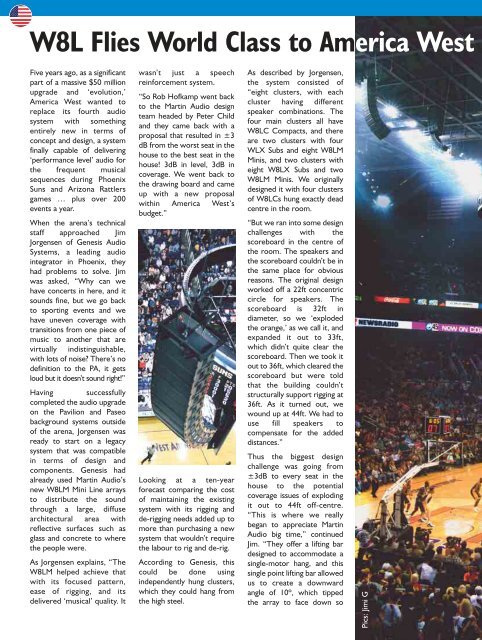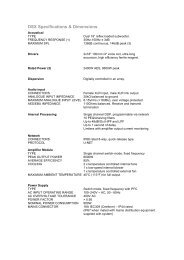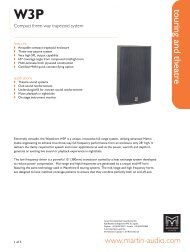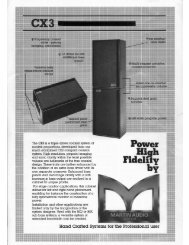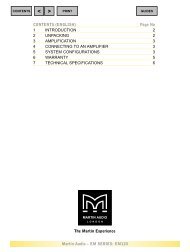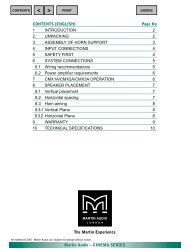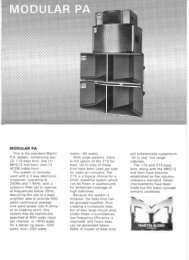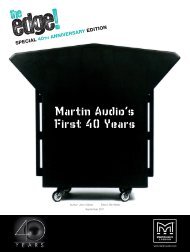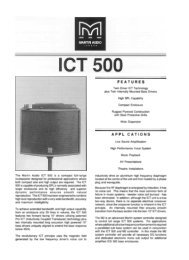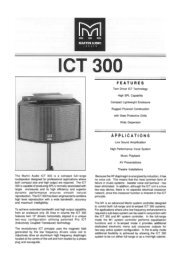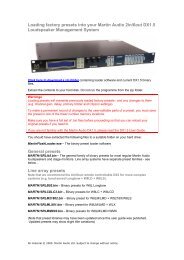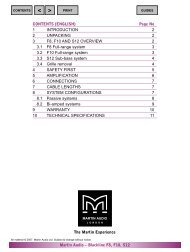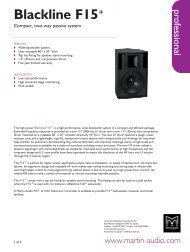Issue Eleven - Martin Audio
Issue Eleven - Martin Audio
Issue Eleven - Martin Audio
You also want an ePaper? Increase the reach of your titles
YUMPU automatically turns print PDFs into web optimized ePapers that Google loves.
W8L Flies World Class to America West<br />
Five years ago, as a significant<br />
part of a massive $50 million<br />
upgrade and ‘evolution,’<br />
America West wanted to<br />
replace its fourth audio<br />
system with something<br />
entirely new in terms of<br />
concept and design, a system<br />
finally capable of delivering<br />
‘performance level’ audio for<br />
the frequent musical<br />
sequences during Phoenix<br />
Suns and Arizona Rattlers<br />
games … plus over 200<br />
events a year.<br />
When the arena’s technical<br />
staff approached Jim<br />
Jorgensen of Genesis <strong>Audio</strong><br />
Systems, a leading audio<br />
integrator in Phoenix, they<br />
had problems to solve. Jim<br />
was asked, “Why can we<br />
have concerts in here, and it<br />
sounds fine, but we go back<br />
to sporting events and we<br />
have uneven coverage with<br />
transitions from one piece of<br />
music to another that are<br />
virtually indistinguishable,<br />
with lots of noise? There’s no<br />
definition to the PA, it gets<br />
loud but it doesn’t sound right!”<br />
Having successfully<br />
completed the audio upgrade<br />
on the Pavilion and Paseo<br />
background systems outside<br />
of the arena, Jorgensen was<br />
ready to start on a legacy<br />
system that was compatible<br />
in terms of design and<br />
components. Genesis had<br />
already used <strong>Martin</strong> <strong>Audio</strong>’s<br />
new W8LM Mini Line arrays<br />
to distribute the sound<br />
through a large, diffuse<br />
architectural area with<br />
reflective surfaces such as<br />
glass and concrete to where<br />
the people were.<br />
As Jorgensen explains, “The<br />
W8LM helped achieve that<br />
with its focused pattern,<br />
ease of rigging, and its<br />
delivered ‘musical’ quality. It<br />
wasn’t just a speech<br />
reinforcement system.<br />
“So Rob Hofkamp went back<br />
to the <strong>Martin</strong> <strong>Audio</strong> design<br />
team headed by Peter Child<br />
and they came back with a<br />
proposal that resulted in ±3<br />
dB from the worst seat in the<br />
house to the best seat in the<br />
house! 3dB in level, 3dB in<br />
coverage. We went back to<br />
the drawing board and came<br />
up with a new proposal<br />
within America West’s<br />
budget.”<br />
Looking at a ten-year<br />
forecast comparing the cost<br />
of maintaining the existing<br />
system with its rigging and<br />
de-rigging needs added up to<br />
more than purchasing a new<br />
system that wouldn’t require<br />
the labour to rig and de-rig.<br />
According to Genesis, this<br />
could be done using<br />
independently hung clusters,<br />
which they could hang from<br />
the high steel.<br />
As described by Jorgensen,<br />
the system consisted of<br />
“eight clusters, with each<br />
cluster having different<br />
speaker combinations. The<br />
four main clusters all have<br />
W8LC Compacts, and there<br />
are two clusters with four<br />
WLX Subs and eight W8LM<br />
Minis, and two clusters with<br />
eight W8LX Subs and two<br />
W8LM Minis. We originally<br />
designed it with four clusters<br />
of W8LCs hung exactly dead<br />
centre in the room.<br />
“But we ran into some design<br />
challenges with the<br />
scoreboard in the centre of<br />
the room. The speakers and<br />
the scoreboard couldn’t be in<br />
the same place for obvious<br />
reasons. The original design<br />
worked off a 22ft concentric<br />
circle for speakers. The<br />
scoreboard is 32ft in<br />
diameter, so we ‘exploded<br />
the orange,’ as we call it, and<br />
expanded it out to 33ft,<br />
which didn’t quite clear the<br />
scoreboard. Then we took it<br />
out to 36ft, which cleared the<br />
scoreboard but were told<br />
that the building couldn’t<br />
structurally support rigging at<br />
36ft. As it turned out, we<br />
wound up at 44ft. We had to<br />
use fill speakers to<br />
compensate for the added<br />
distances.”<br />
Thus the biggest design<br />
challenge was going from<br />
±3dB to every seat in the<br />
house to the potential<br />
coverage issues of exploding<br />
it out to 44ft off-centre.<br />
“This is where we really<br />
began to appreciate <strong>Martin</strong><br />
<strong>Audio</strong> big time,” continued<br />
Jim. “They offer a lifting bar<br />
designed to accommodate a<br />
single-motor hang, and this<br />
single point lifting bar allowed<br />
us to create a downward<br />
angle of 10º, which tipped<br />
the array to face down so<br />
Pics: Jimi G


